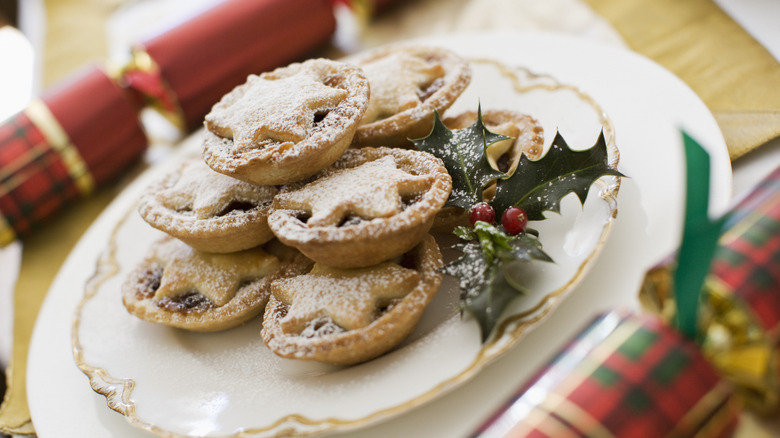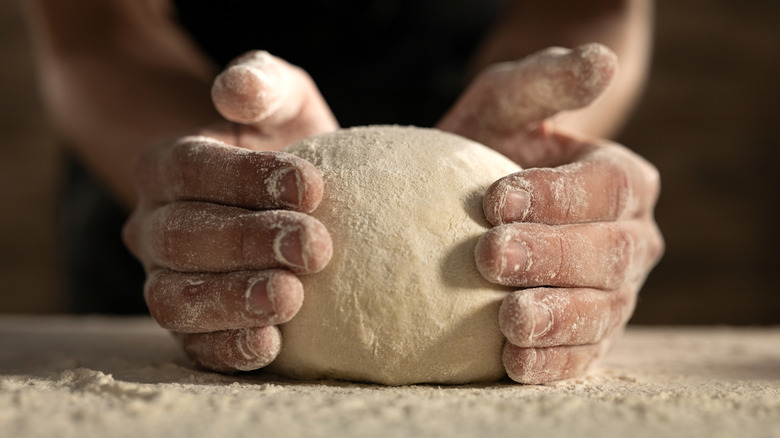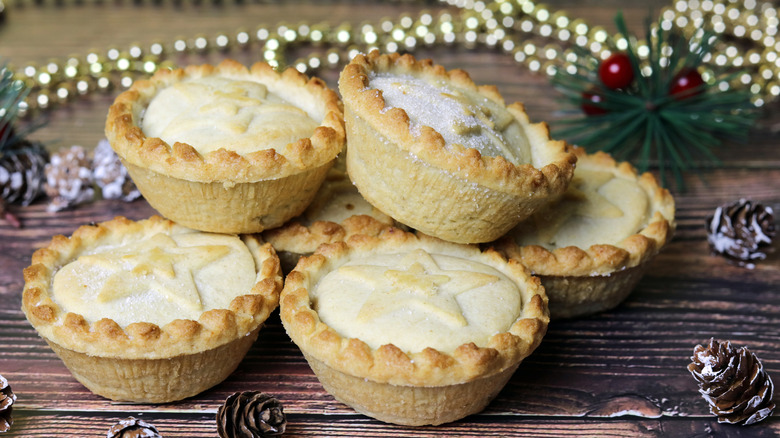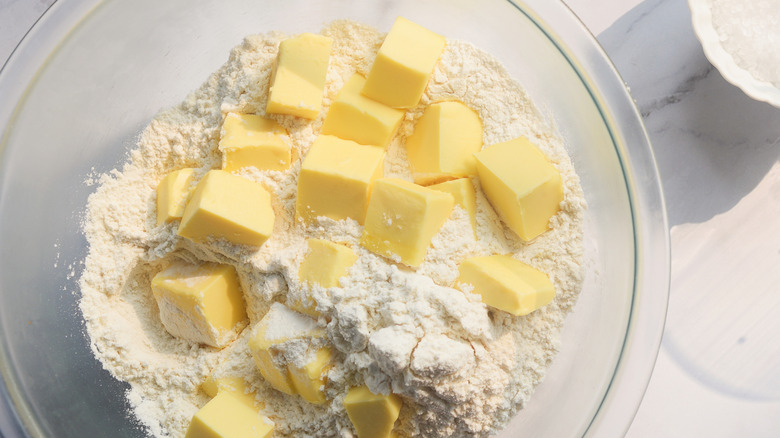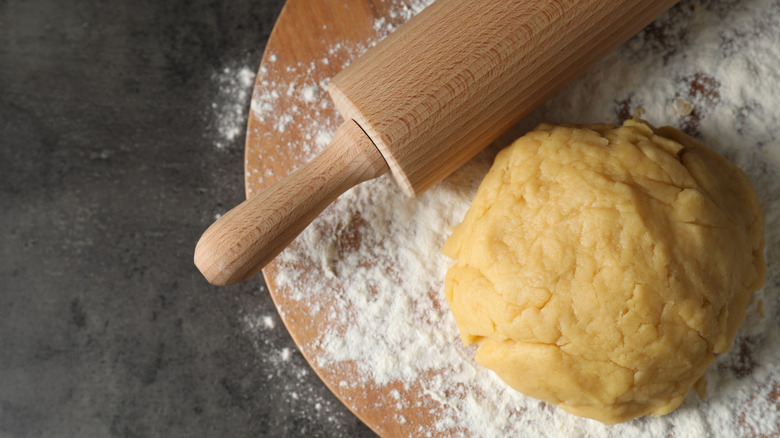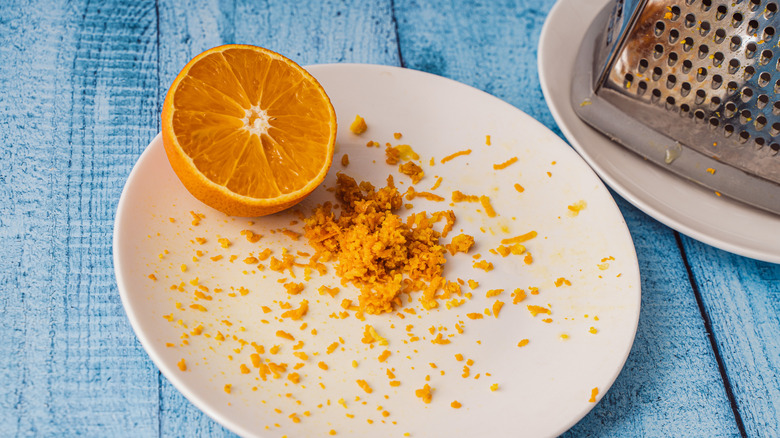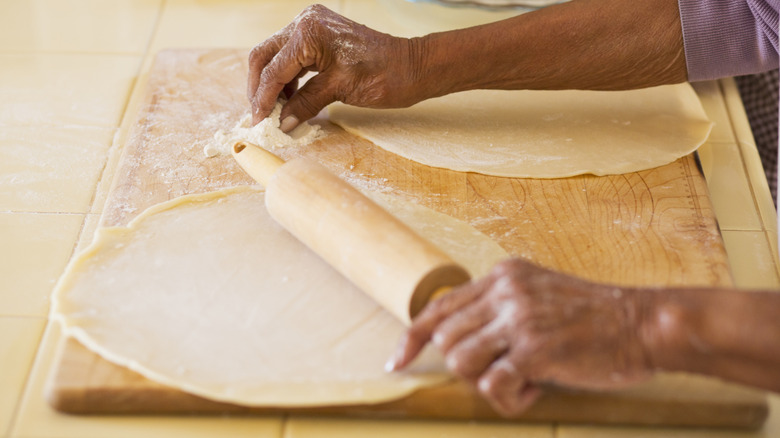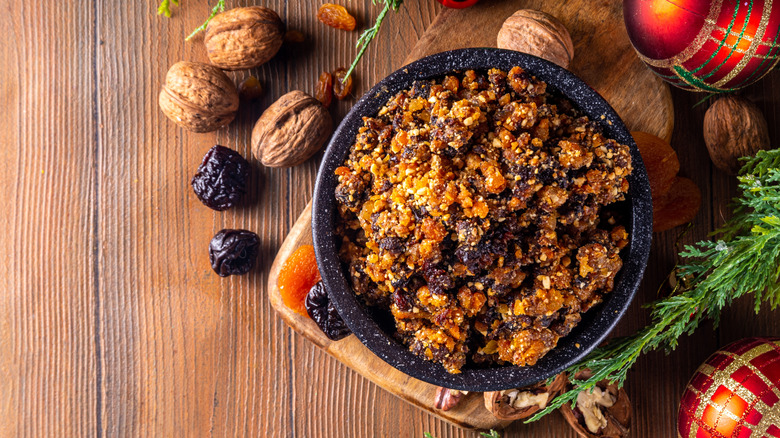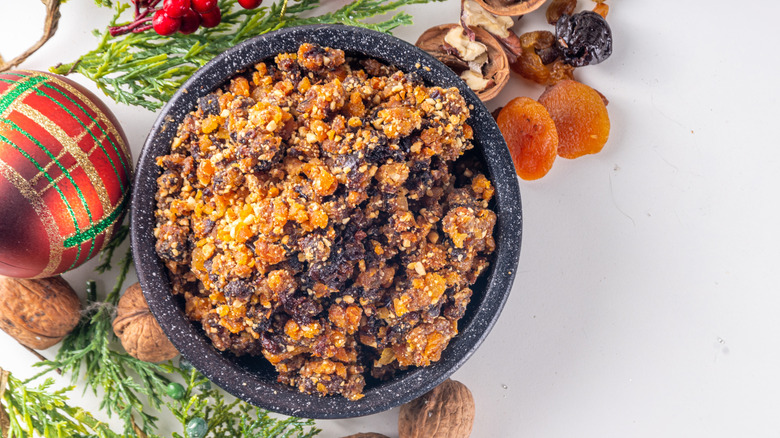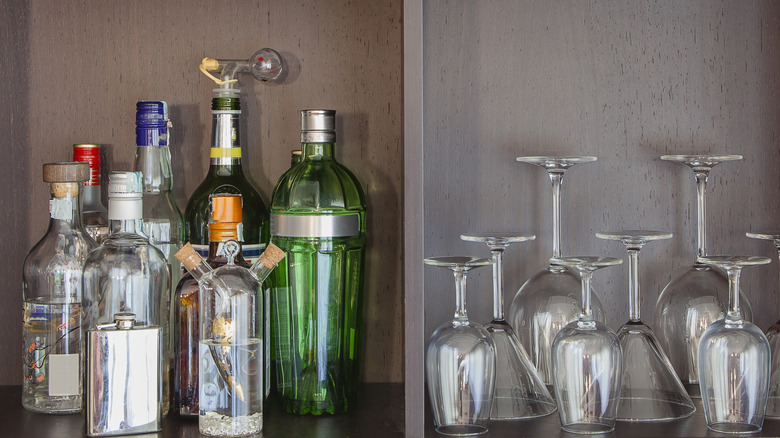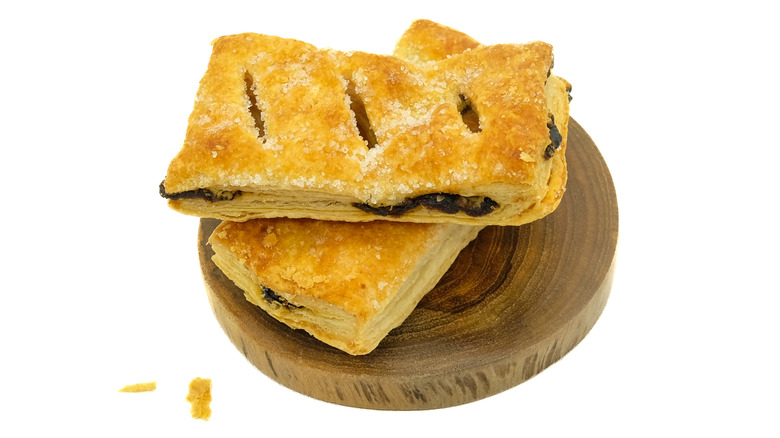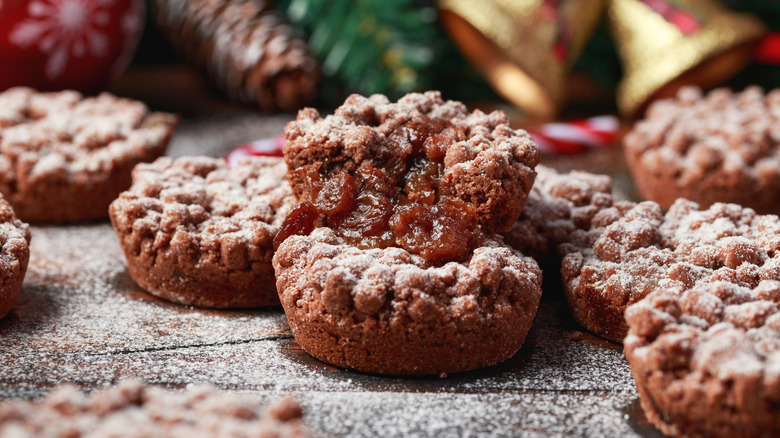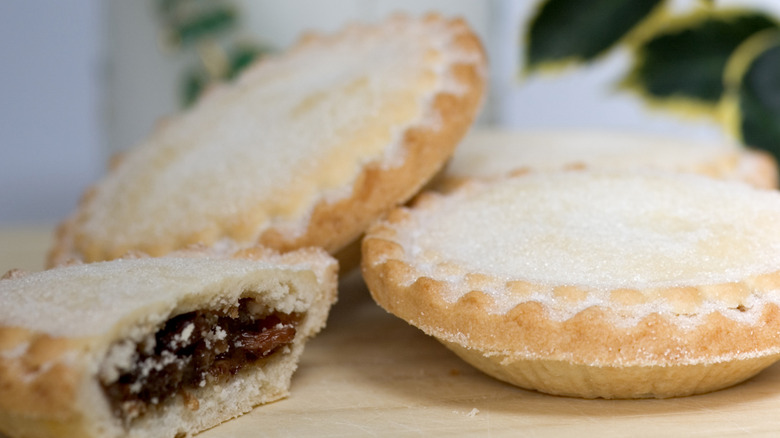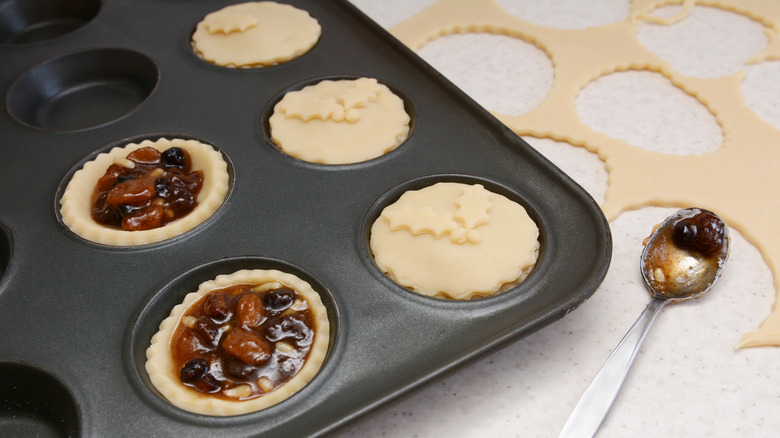Mistakes Everyone Makes With Mince Pies
As the days get colder and the nights get longer, mince pie season approaches. These little pies are a British invention traditionally eaten around Christmas, but they've started spreading to other parts of the world. Baking them from scratch can be a challenge though, and there are all kinds of mistakes home bakers make with mince pies.
These festive treats have been around longer than many people realize. The earliest versions date back to the 1300s, but they became more similar to the ones we'd recognize today by the 1600s. This is also when they started becoming associated with Christmas. Still, despite being around all these years, a lot of people can't get them right.
If you decide to bake your own, you'll want to try to avoid some of the common missteps and pitfalls folks make with them. As a Brit with professional baking experience, I've made my fair share of mince pies and know how to bake unforgettable ones. A big part of it is getting the pastry right — it needs to be a perfect shortcrust to do these pies justice. But the "mincemeat" filling is also important, and homemade versions are best. Finally, you need to get the bake right. All this will add up to the perfect mince pies.
Reaching for store-bought pastry
Store-bought pastry just isn't the answer when making mince pies. It might be tempting to grab a packet of ready-made pastry, so all you need to do is roll it out — or if it comes pre-rolled, cut out circles to make the pie cases. Instead, for the best results, you need to make the pastry yourself.
Making pastry from scratch is daunting when you're trying it for the first time. But once you know how, you'll wonder what the fuss is all about. The first step is to rub the butter into the flour. Unlike other recipes that often call for room temperature butter, it needs to be cold when making pastry. It's important to keep the ingredients cold, so chilly hands can be a bonus here. However, using a pastry cutter or a food processor is optimal for this step. Not only does it speed things up but it can improve your pastry too. Then, add just enough water to bring the mixture together into a firm dough.
And, that's pretty much it — you've made pastry. Sure, there's still chilling, rolling, and cutting to do, but the dough itself is done. Isn't that so much simpler than you thought? Although you can upgrade store-bought pie crust, it isn't the right call for mince pies.
Making the wrong kind of pastry
Classic American pastry is known for being light and flaky, and it fits somewhere between a shortcrust and a rough puff. It's made with a technique that creates pockets of fat in the dough, which puff up and form flaky layers when baked. But, this isn't what you want for mince pies — and it's where American bakers can go wrong with them.
What you need instead is shortcrust pastry. It has a "short" texture, which means it's tender and crumbly while still holding together. This is a similar texture to shortbread — which has "short" in its name for a reason. With shortcrust, you don't get the same flakiness as in classic American pastry, but you do get a crumbly, tender, melt-in-the-mouth texture.
You might be used to a flakier American pie crust but both pastries have their place — shortcrust's place is wrapped around a delicious mince pie filling. It might mean you have to deviate from your usual favorite pie crust recipe but trust us on this one.
Using too little butter in the pastry
Now you know that you need shortcrust pastry for mince pies — and you need to make it yourself. But, you might be using too little butter if you're following a conventional shortcrust recipe. To get it as tender as possible, you need to use extra butter — or nondairy butter sticks if you're trying to make vegan pastry. While using real butter is a mistake in some types of pastry, this isn't true for shortcrust.
For mince pies, you want the pastry to be extra soft and crumbly. It's part of what makes these sweet treats special. When making shortcrust, coating the flour with fat — by rubbing or cutting it in — before adding the water creates the short texture. The fat interferes with gluten formation so the pastry doesn't turn out too tough or chewy. Adding extra fat takes this even further, ensuring the pastry is amazingly crumbly.
Talking to The Independent, former contestant of "The Great British Baking Show" Ian Cumming said that he slightly increases the ratio of butter to flour in his mince pie pastry. Normally, shortcrust uses one part butter to two parts flour, but he increases the butter so it's about 1 ⅓ parts butter to two parts flour, giving him the texture he's aiming for.
Overworking the pastry
As you will have gathered by now, the whole point of shortcrust is its crumbly, tender texture. If you end up with tough pastry, there are several things you might have done wrong. But perhaps the most common mistake is overworking the dough.
Once you know a little bit about the science of baking, it all makes sense. Luckily, this is something I nerd out on, so you're in the right place. Gluten is what gives many baked goods their texture. It's responsible for the chewiness of a sourdough loaf and the fine crumb of a sponge cake. It forms when you add water to wheat, rye, or spelt flour. As you mix a batter or work a dough, gluten strands develop into a network, which makes a tougher, chewier texture.
Depending on the recipe, you might want a lot of gluten development or only a little. Bread usually calls for extreme gluten formation, which is why you might knead bread dough for 20 minutes. With shortcrust pastry, however, you want to keep gluten formation to an absolute minimum. This means you should work the dough as little as possible. Once you add the water, only mix the ingredients as much as you need to form a dough. You definitely shouldn't knead it. Roll it out with as few strokes as you can manage. And, if you reroll the offcuts, try not to work them too much.
Not considering flavoring the pastry
Did you know you can flavor your pastry for mince pies — or for any other pies, for that matter? It's an option that most people overlook, but it can take your bake to the next level. If you're pretty good at making basic mince pies, this is an easy step you could take to elevate them.
But, what flavors can you add to your pastry? Some people make gingerbread mince pies, which involves adding ginger and cinnamon in with the pastry's dry ingredients. It's simple yet effective, and gingerbread is particularly Christmassy. However, you can use other warm spices too, such as cardamom, allspice, nutmeg, and cloves. Combining them in various ratios can give you a range of flavors — but they always have Christmas vibes.
Other options for flavoring your pastry include ground almonds and citrus zest. Or, you can use a combination of all of these. Using ground almonds in place of a portion of the flour can also help you achieve that short, crumbly texture by reducing the quantity of gluten in the pastry.
Rolling the pastry straight after making it
Eagerness to finish making your mince pies is totally understandable. There are a number of steps you have to get through before you can enjoy them — making the mincemeat, crafting the pastry, assembling, and baking. So, we get the impulse to save time by rolling out the pastry as soon as you're done making it, but patience is a virtue here.
Chilling your dough is essential because it helps the gluten relax, which makes it easier to roll and keeps your pie crust from shrinking in the oven. If your pastry is too warm it can also become greasy and difficult to handle. You only need to chill pastry for around 15 to 30 minutes, until it feels cool and firm. If you've chilled it for more than a couple of hours, leave it at room temperature for five to 10 minutes before attempting to roll it to prevent it from cracking.
Begin by using a rolling pin to tap lightly over the surface of the ball of pastry to flatten it into a rough circle. When the diameter has at least doubled in size, start to roll it with short rather than long strokes. Turn the pastry 90 degrees every few rolls to get an even circle. This is how you roll dough without overstretching or overworking it, and accidentally turning it tough.
Using store-bought mincemeat
If you're using store-bought mincemeat to fill your pies, you're doing it wrong. Although it's available in stores in North America and is fine to use in a pinch, making it yourself from scratch is the way to go if you're looking for more flavor. But first, what is mincemeat, really? Despite the name, it typically doesn't contain meat — although it once did, long in the past. Rather, it's a mixture of ingredients like fruit, nuts, alcohol, sugar, spices, and a type of fat called suet. While suet traditionally comes from beef, vegetarian suet is usually used today.
There are plenty of mincemeat recipes online, and while they're all slightly different, a common feature is that you'll usually need to start preparing the mixture at least a day before you want to use it. The ingredients have to mingle together for 12 hours or so before cooking and cooling. At this point, you can use the mixture to fill your pies, or you can store it in sterilized jars for several years — although it's best used within a year.
Not making the mincemeat flavorful enough
A common mince pie mistake is missing opportunities to boost the flavors in the mincemeat. You might simply mix all the ingredients together without taking extra steps to develop deeper, richer notes. This is an error — but one that's easy enough to rectify.
You can improve your mincemeat by poaching fruit before mixing it into the filling. Simmer fruits like apples, pears, dates, apricots, cranberries, and raisins in a mixture of water and sugar until they become soft and jammy. This process concentrates their natural sweetness and creates a more complex flavor. You can add whole spices while poaching, like star anise and cinnamon sticks.
You can also try toasting your spices in a dry pan for a minute before adding them in to boost the filling's flavor. Don't skimp on those spices, either. Use dark brown sugar instead of white sugar, as it adds rich caramel notes. Citrus zest also helps to lift the mixture and bring a brightness that can be lacking in some examples of mincemeat. Take every opportunity you can to add extra flavor and more layers of complexity — the results will be worthwhile.
Failing to experiment with different types of alcohol
Most modern mincemeat contains alcohol. While it isn't a prominent flavor — mince pies don't taste particularly boozy — it brings a depth to the filling that can be lacking without it. And, of course, it helps people get in the festive spirit. You can match the perfect booze to your other ingredients or just use what you have on hand.
Brandy is among the most classic choices, with its warm, rich flavor that complements the fruits and spices in mincemeat. Rum is another traditional option, particularly a dark variety, which brings a molasses-like depth. Some bakers love how it adds a slightly caramel undertone to their filling.
However, you can absolutely experiment with other alcohols. Whiskey introduces smoky and woody notes that are deliciously complex. Port offers a sweet, deep flavor that works well with dried fruits. Or, for something completely different, try an unexpected choice. Amaretto brings an almond sweetness, sloe gin has sweet fruity notes perfect for mince pies, and Grand Marnier infuses a citrus brightness.
Always sticking to conventional forms
Basic mince pies are so last century, and you'll limit yourself by focusing on conventional forms. There are so many alternatives to classic mince pies to try, so it's about time to branch out. Yes, we'd recommend cutting your teeth on the classic type but once you've learned the ropes, don't stop there. Modern takes on mince pies can be just as delicious — and super-fun to experiment with.
Mincemeat palmiers are a cross between a palmier and a mince pie. They involve rolling mincemeat into puff pastry before slicing and baking it as individual pastries. Meanwhile, mincemeat samosas are a sweet, festive take on a savory classic, with mincemeat folded inside a triangle of filo pastry. Or, mincemeat baklava is another way to use the filling without giving up on pastry altogether. Don't let tradition get in your way of trying new alternatives to a classic mince pie.
Not embracing chocolate mince pies
Love chocolate and aren't so big on fruity desserts? Well, you don't have to give up on mince pies altogether, just embrace an alternative. Chocolate mince pies are a spin on the traditional holiday treat. You don't have to go all-in with chocolate — even small additions can make a difference. Not even considering them is a mistake you want to avoid.
For a light touch, try stirring dark chocolate chips directly into your standard mincemeat. The chips will melt slightly during baking, leaving you with pockets of chocolate throughout the filling. This is great if you want to experiment without totally reinventing the recipe. If you're feeling more adventurous, consider making a full chocolate version. Start by creating a chocolate pastry crust using cocoa powder mixed into your regular shortcrust dough. For the filling, make a chocolate mincemeat by adding melted dark chocolate or cocoa in with the traditional ingredients.
Orange pairs beautifully with chocolate mince pies too. Add some zest to your filling or use orange-flavored chocolate. A splash of Grand Marnier or orange liqueur is also delicious. As for spices, cinnamon is a perfect partner for chocolate, so increase the amount in your recipe for a tasty chocolate mince pie.
Underbaking or overbaking mince pies
It's easy to either overbake or underbake mince pie, both of which leave something to be desired. It's important to follow the recipe to get the bake right. However, you should also use your senses and know when to follow your own instincts.
Leaving pies in the oven for too long or setting the oven too high can lead to dry or burnt pastry that doesn't taste good. On the other hand, not leaving the pies in the oven for long enough or using a temperature that's too low can leave the pastry pale and soft. This means you won't get the crumbly texture you want from shortcrust or the toasted flavor that comes from golden brown pastry.
Place your pies in the oven for the length of time specified in the recipe, but also keep an eye on them. If they're browning quicker than expected, you may need to turn the temperature down or take them out of the oven early. On the other hand, if they're still pale when the timer goes, give them an extra minute or two and wait until the pastry's golden brown before removing the mince pies from the oven.
Failing to get them out of the tin neatly
Good shortcrust pastry is on the fragile side, and a common error is failing to remove the pies from their tins without damaging them. It's totally frustrating to make perfect mince pies and then mess them up at the final hurdle.
Often, part of the trouble is using the wrong pan, so if you're planning on making them more than once, consider buying mince pie tins. These have 12 holes of a similar diameter to those in muffin tins, but they're shallower. Of course, buying a dedicated pan for a treat you're only likely to make during the holidays isn't for everyone. That's why many people use muffin pans, either under filling them or making deep-dish mince pies.
This makes them trickier to get out, though. A simple solution is to use a strip of baking parchment, which sits across the middle of each hole in the tray with some overhang on each side. Once the pies have cooled in the tin, you can gently pull up on each side of the parchment paper to lift the pie out of the hole.
